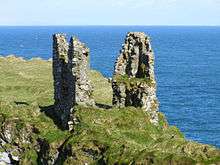Dunseverick Castle
| Dunseverick Castle | |
|---|---|
| County Antrim, Northern Ireland | |
|
Dunseverick Castle | |
| Coordinates | 55°13′52″N 6°23′42″W / 55.231°N 6.395°WCoordinates: 55°13′52″N 6°23′42″W / 55.231°N 6.395°W |
| Type | Castle |
| Site information | |
| Controlled by | Northern Ireland Environment Agency |
| Open to the public | Yes |
| Condition | In ruins |

Dunseverick Castle is situated in County Antrim, Northern Ireland, near the small village of Dunseverick and the Giant's Causeway. Dunseverick Castle and earthworks are Scheduled Historic Monuments in the townland of Feigh, in Moyle District Council area, at grid ref: C9871 4467.[1]
Dunseverick Castle and the peninsula on which it stands were given to the National Trust in 1962 by local farmer Jack McCurdy. The Causeway Cliff Path also runs past on its way to Dunseverick Harbour to the east and to the Giant's Causeway to the west.
History
Saint Patrick is recorded as having visited Dunseverick castle in the 5th century AD, where he baptized Olcán, a local man who later became a Bishop of Ireland.[2] The original stone fort that occupied the position was attacked by Viking raiders in 870 AD.
In the later part of the 6th century AD, this was the seat of Fergus Mor MacEirc (Fergus the Great). Fergus was King of Dalriada and great-uncle of the High King of Ireland, Muirceartaigh (Murtagh) MacEirc. It is the 500 AD departure point from Ireland of the Lia Fail or coronation stone. Murtagh loaned it to Fergus for the latter's coronation in western Scotland part of which Fergus had settled as his sea-kingdom expanded.
The O'Cahan family held it from circa 1000 AD to circa 1320 AD, then regained it in the mid 16th century. Last one to have the castle was Giolla Dubh Ó Catháin, who left it in 1657 to settle in the Craig/Lisbellanagroagh area. Post 1660 they use the anglicised name McCain/O'Kane.
The castle was captured and destroyed by General Robert Munro in 1642[3] and his Cromwellian troops in the 1650s, and today only the ruins of the gatelodge remain. A small residential tower survived until 1978 when it eventually surrendered to the sea below.
It was a 'key' ancient site in Ireland. One of the five great royal highways, or slighte of ancient Ireland, Slige Midluachra, had its terminal point at Dunseverick castle,[4] running from here to Emain Macha and further to Tara and the fording point on the Liffey at what is now Dublin.
See also
| Wikimedia Commons has media related to Dunseverick Castle. |
References
- ↑ "Dunseverick" (PDF). Environment and Heritage Service NI - Scheduled Historic Monuments. Retrieved 2007-12-03.
- ↑ "North Antrim". North Antrim website.
- ↑ "General Robert Munro".
- ↑ "An Analysis of Pre-Christian Ireland Using Mythology and A GIS". Retrieved 14 June 2015.
